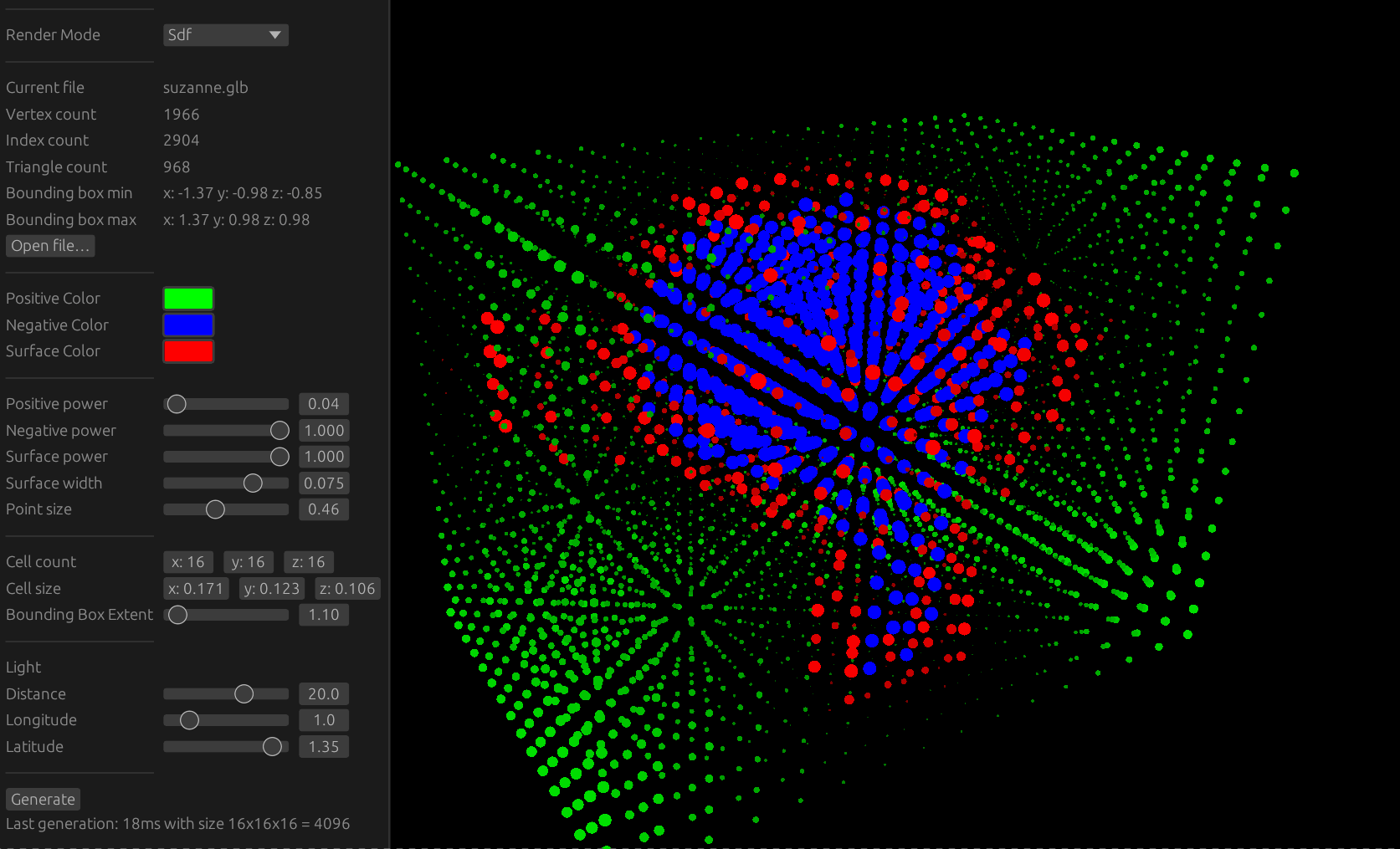This repository contains two crates:
mesh_to_sdf: a library to convert a mesh to a signed distance field (SDF).mesh_to_sdf_client: a visualization client for the SDF of a mesh.
documentation: https://docs.rs/mesh_to_sdf/latest/mesh_to_sdf/
This crate provides two entry points:
- [
generate_sdf]: computes the signed distance field for the mesh defined byverticesandindicesat the pointsquery_points. - [
generate_grid_sdf]: computes the signed distance field for the mesh defined byverticesandindiceson a [Grid].
use mesh_to_sdf::{generate_sdf, generate_grid_sdf, SignMethod, AccelerationMethod, Topology, Grid};
// vertices are [f32; 3], but can be cgmath::Vector3<f32>, glam::Vec3, etc.
let vertices: Vec<[f32; 3]> = vec![[0.5, 1.5, 0.5], [1., 2., 3.], [1., 3., 7.]];
let indices: Vec<u32> = vec![0, 1, 2];
// query points must be of the same type as vertices
let query_points: Vec<[f32; 3]> = vec![[0.5, 0.5, 0.5]];
// Query points are expected to be in the same space as the mesh.
let sdf: Vec<f32> = generate_sdf(
&vertices,
Topology::TriangleList(Some(&indices)), // TriangleList as opposed to TriangleStrip
&query_points,
AccelerationMethod::RtreeBvh, // Use an r-tree and a bvh to accelerate queries.
);
for point in query_points.iter().zip(sdf.iter()) {
// distance is positive outside the mesh and negative inside.
println!("Distance to {:?}: {}", point.0, point.1);
}
// if you can, use generate_grid_sdf instead of generate_sdf as it's optimized and much faster.
let bounding_box_min = [0., 0., 0.];
let bounding_box_max = [10., 10., 10.];
let cell_count = [10, 10, 10];
let grid = Grid::from_bounding_box(&bounding_box_min, &bounding_box_max, cell_count);
let sdf: Vec<f32> = generate_grid_sdf(
&vertices,
Topology::TriangleList(Some(&indices)),
&grid,
SignMethod::Raycast, // How the sign is computed.
// Raycast is robust but requires the mesh to be watertight.
// and is more expensive.
// Normal might leak negative distances outside the mesh
); // but works for all meshes, even surfaces.
for x in 0..cell_count[0] {
for y in 0..cell_count[1] {
for z in 0..cell_count[2] {
let index = grid.get_cell_idx(&[x, y, z]);
log::info!("Distance to cell [{}, {}, {}]: {}", x, y, z, sdf[index as usize]);
}
}
}Indices can be of any type that implements Into<u32>, e.g. u16 and u32. Topology can be list or strip.
If the indices are not provided, they are supposed to be 0..vertices.len().
For vertices, this library aims to be as generic as possible by providing a trait Point that can be implemented for any type.
Implementations for most common math libraries are gated behind feature flags. By default, [f32; 3] and nalgebra::[Point3, Vector3] are provided.
If you do not find your favorite library, feel free to implement the trait for it and submit a PR or open an issue.
This crate provides two methods to compute the sign of the distance:
- [
SignMethod::Raycast] (default): a robust method to compute the sign of the distance. It counts the number of intersections between a ray starting from the query point and the triangles of the mesh. It only works for watertight meshes, but guarantees the sign is correct. - [
SignMethod::Normal]: uses the normals of the triangles to estimate the sign by doing a dot product with the direction of the query point. It works for non-watertight meshes but might leak negative distances outside the mesh.
Using Raycast is slower than Normal but gives better results. Performances depends on the triangle count and method used.
On big dataset, Raycast is 5-10% slower for grid generation and rtree based methods. On smaller dataset, the difference can be worse
depending on whether the query is triangle intensive or query point intensive.
For bvh the difference is negligible between the two methods.
For generic queries, you can use acceleration structures to speed up the computation.
- [
AccelerationMethod::None]: no acceleration structure. This is the slowest method but requires no extra memory. Scales really poorly. - [
AccelerationMethod::Bvh]: Bounding Volume Hierarchy. Accepts aSignMethod. - [
AccelerationMethod::Rtree]: R-tree. UsesSignMethod::Normal. The fastest method assuming you have more than a couple thousands of queries. - [
AccelerationMethod::RtreeBvh] (default): Uses R-tree for nearest neighbor search and Bvh forSignMethod::Raycast. 5-10% slower thanRtreeon big datasets.
If your mesh is watertight and you have more than a thousand queries/triangles, you should use AccelerationMethod::RtreeBvh for best performances.
If it's not watertight, you can use AccelerationMethod::Rtree instead.
Rtree methods are 3-4x faster than Bvh methods for big enough data. On small meshes, the difference is negligible.
AccelerationMethod::None scales really poorly and should be avoided unless for small datasets or if you're really tight on memory.
To use your favorite math library with mesh_to_sdf, you need to add it to mesh_to_sdf dependency. For example, to use glam:
[dependencies]
mesh_to_sdf = { version = "0.2.1", features = ["glam"] }Currently, the following libraries are supported:
- [cgmath] ([
cgmath::Vector3<f32>]) - [glam] ([
glam::Vec3]) - [mint] ([
mint::Vector3<f32>] and [mint::Point3<f32>]) - [nalgebra] ([
nalgebra::Vector3<f32>] and [nalgebra::Point3<f32>]) [f32; 3]
[nalgebra] is always available as it's used internally in the bvh tree.
If you want to serialize and deserialize signed distance fields, you need to enable the serde feature.
This features also provides helpers to save and load signed distance fields to and from files via save_to_file and read_from_file.
Load a gltf/glb file and visualize its signed distance field.
Credits:
- this app started with rust_wgpu_hot_reload as template.
- wgpu examples were also extensively used to keep track of
wgpu <-> winitintegration after eachwinitupdate.
This project is still in its early stages. Here is a list of things that are planned for (near) the future:
- [lib] Robust inside/outside checking with raycast
- [lib] Implement
Pointfor common libraries (cgmath,nalgebra,mint, ...) - [lib] Optimize
mesh_to_sdfwith a bvh - [lib] Optimize
mesh_to_sdfby computing on the gpu - [lib] Serialize/Deserialize with
serdeand save/load to file - [lib] General optimizations
- [lib] Tests/Benchmarks/Examples
- [lib] Methods to sample the surface
- [client] Display meshes
- [client] Raymarch the surface
- [client] Voxelize the mesh
- [client] Undo/Redo
- [client] CLI


